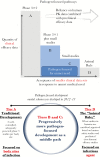White Paper: Developing Antimicrobial Drugs for Resistant Pathogens, Narrow-Spectrum Indications, and Unmet Needs
- PMID: 28475768
- PMCID: PMC5853321
- DOI: 10.1093/infdis/jix211
White Paper: Developing Antimicrobial Drugs for Resistant Pathogens, Narrow-Spectrum Indications, and Unmet Needs
Abstract
Despite progress in antimicrobial drug development, a critical need persists for new, feasible pathways to develop antibacterial agents to treat people infected with drug-resistant bacteria. Infections due to resistant gram-negative bacilli continue to cause unacceptable morbidity and mortality rates. Antibacterial agents have been historically studied in noninferiority clinical trials that focus on a single site of infection (eg, complicated urinary tract infections, intra-abdominal infections), yet these designs may not be optimal, and often are not feasible, for study of infections caused by drug-resistant bacteria. Over the past several years, multiple stakeholders have worked to develop consensus regarding paths forward with a goal of facilitating timely conduct of antimicrobial development. Here we advocate for a novel and pragmatic approach and, toward this end, present feasible trial designs for antibacterial agents that could enable conduct of narrow-spectrum, organism-specific clinical trials and ultimately approval of critically needed new antibacterial agents.
Keywords: antibiotic development; antimicrobial resistance.
© The Author 2017. Published by Oxford University Press for the Infectious Diseases Society of America. All rights reserved. For permissions, e-mail: journals.permissions@oup.com.
Figures
Comment in
-
Stepping Off the Resistance Treadmill.J Infect Dis. 2017 Jul 15;216(2):150-152. doi: 10.1093/infdis/jix212. J Infect Dis. 2017. PMID: 28475769 No abstract available.
Similar articles
-
White paper: recommendations on the conduct of superiority and organism-specific clinical trials of antibacterial agents for the treatment of infections caused by drug-resistant bacterial pathogens.Clin Infect Dis. 2012 Oct;55(8):1031-46. doi: 10.1093/cid/cis688. Epub 2012 Aug 13. Clin Infect Dis. 2012. PMID: 22891041 Free PMC article.
-
10 x '20 Progress--development of new drugs active against gram-negative bacilli: an update from the Infectious Diseases Society of America.Clin Infect Dis. 2013 Jun;56(12):1685-94. doi: 10.1093/cid/cit152. Epub 2013 Apr 17. Clin Infect Dis. 2013. PMID: 23599308 Free PMC article.
-
Cefiderocol: A Siderophore Cephalosporin with Activity Against Carbapenem-Resistant and Multidrug-Resistant Gram-Negative Bacilli.Drugs. 2019 Feb;79(3):271-289. doi: 10.1007/s40265-019-1055-2. Drugs. 2019. PMID: 30712199 Review.
-
Progress in the Fight Against Multidrug-Resistant Bacteria 2005-2016: Modern Noninferiority Trial Designs Enable Antibiotic Development in Advance of Epidemic Bacterial Resistance.Clin Infect Dis. 2017 Jul 1;65(1):141-146. doi: 10.1093/cid/cix246. Clin Infect Dis. 2017. PMID: 29017263 Free PMC article. Review.
-
Resistant gram-negative bacilli: A neglected healthcare crisis?Am J Health Syst Pharm. 2007 Dec 1;64(23 Suppl 14):S3-21; quiz S22-4. doi: 10.2146/ajhp070477. Am J Health Syst Pharm. 2007. PMID: 18029939
Cited by
-
Pathogen-Targeted Clinical Development to Address Unmet Medical Need: Design, Safety, and Efficacy of the ATTACK Trial.Clin Infect Dis. 2023 May 1;76(Suppl 2):S210-S214. doi: 10.1093/cid/ciad097. Clin Infect Dis. 2023. PMID: 37125468 Free PMC article. Clinical Trial.
-
Considerations and Caveats in Combating ESKAPE Pathogens against Nosocomial Infections.Adv Sci (Weinh). 2019 Dec 5;7(1):1901872. doi: 10.1002/advs.201901872. eCollection 2020 Jan. Adv Sci (Weinh). 2019. PMID: 31921562 Free PMC article. Review.
-
Translational PK/PD for the Development of Novel Antibiotics-A Drug Developer's Perspective.Antibiotics (Basel). 2024 Jan 11;13(1):72. doi: 10.3390/antibiotics13010072. Antibiotics (Basel). 2024. PMID: 38247631 Free PMC article. Review.
-
Monte Carlo simulation evaluation of tigecycline dosing for bacteria with raised minimum inhibitory concentrations in non-critically ill adults.Eur J Clin Pharmacol. 2021 Feb;77(2):197-205. doi: 10.1007/s00228-020-02998-7. Epub 2020 Sep 25. Eur J Clin Pharmacol. 2021. PMID: 32975650
-
The immune responses to different Uropathogens call individual interventions for bladder infection.Front Immunol. 2022 Aug 23;13:953354. doi: 10.3389/fimmu.2022.953354. eCollection 2022. Front Immunol. 2022. PMID: 36081496 Free PMC article. Review.
References
-
- O’Neill, J; The Review on Antimicrobial Resistance. Tackling drug-resistant infections globally: final report and recommendations 2016. http://amr-review.org/sites/default/files/160525_Final%20paper_with%20co... Accessed 25 August 2016.
-
- Pogue JM, Ortwine JK, Kaye KS. Optimal usage of colistin: are we any closer? Clin Infect Dis 2015; 61:1778–80. - PubMed
-
- Xavier BB, Lammens C, Ruhal R, et al. Identification of a novel plasmid-mediated colistin-resistance gene, mcr-2, in Escherichia coli, Belgium, June 2016. Euro Surveill 2016; 21:1–6. doi:10.2807/1560,7917.ES.2016.21.27.30280. - PubMed
-
- Abbasi J. Infectious disease expert sees threat from colistin-resistant superbug. JAMA 2016; 316:806–7. - PubMed
Publication types
MeSH terms
Substances
Grants and funding
LinkOut - more resources
Full Text Sources
Other Literature Sources
Medical
Miscellaneous


